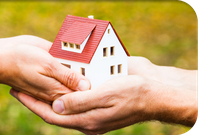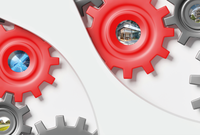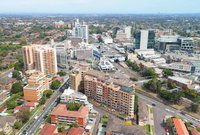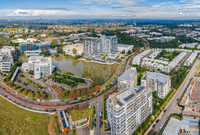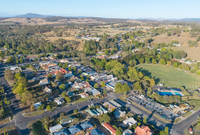Affordable & Liveable Property Guide 2nd Half 2020 - Brisbane
Median property prices in Brisbane Metro increased by 4.3% for houses to $678,000 from 2019 to 20201 and softened by -1.1% to $435,000 for units during the same period. Limited stock and high demand have supported median price growth for houses, showing resilience throughout COVID-19. A softer median unit price is expected, particularly due to the leftover oversupply from late 2016 to 2017.

Overview
Median property prices in Brisbane Metro increased by 4.3% for houses to $678,000 from 2019 to 20201 and softened by -1.1% to $435,000 for units during the same period. Limited stock and high demand have supported median price growth for houses, showing resilience throughout COVID-19. A softer median unit price is expected, particularly due to the leftover oversupply from late 2016 to 2017.
Brisbane Metro houses have continued to show steady price growth in the past five years, instilling confidence in property owners. This is key for the Brisbane Metro market, as it signals a growing market despite remaining the more affordable option when compared with Sydney (median house price $1,630,000) and Melbourne (median house price $990,000).
A key finding in this report was that most of the affordable and liveable suburbs identified were on the north side of Brisbane Metro. This is a similar finding to 1st Half 2019€, 2nd Half 2019¥, and 1st Half 2020₳ reports. Brisbane’s northside has been a focus of development for the past three years, allowing more affordable suburbs to satisfy the liveability criteria. This is good news for first home buyers, who for a period of time had discounted the north side as a potential prospect.
In addition, only one suburb with softening annual median house or unit price growth had to be considered. This is in contrast with Sydney, which suggests that despite COVID-19 conditions there is high market resilience in Brisbane. That said, softer annual median house or unit price growth presents unique opportunities for first home buyers.
Table 1 highlights top suburbs in Brisbane Metro based on price growth and total estimated value of projects commencing in the 2nd half of 20202.

Access to Market
The dominant proportion of houses sold in Brisbane Metro during 20201 (Figures 1 and 2) were in the lower-middle price bracket of $500,000 to $700,000 (35.9%). Units also experienced high buyer activity within the lower-middle price bracket of $300,000 to $400,000 (27.4%). Brisbane Metro provides excellent opportunities for first home buyers compared with Sydney and Melbourne, in terms of comparable affordability.


Affordable & Liveable Suburbs
To identify affordable and liveable suburbs premiums of 38% for houses and 0% for units were added to the Queensland (QLD) average home loan, which were below those required to reach Brisbane Metro’s median prices (64% for houses and 5% for units). Thus, the affordable and liveable suburbs are below Brisbane’s median prices, meaning that the suburbs identified within this report are more affordable for buyers.
Considering all methodology criteria (property trends, investment, affordability, development, and liveability), Tables 2 and 3 identify key suburbs that property watchers should focus on.


In September 2020, house rental yields in Brisbane Metro were 3.7%. In the 12 months to Q3 2020, the median house rents grew by 2.2% to $470 per week, while average days on the market declined by -25.9% to 20 days. Overall, the Brisbane Metro rental house market has remained resilient throughout COVID-19.
In September 2020, Brisbane Metro recorded a low vacancy rate of 2.0%, well below that of Sydney Metro (3.5%) and Melbourne Metro (3.8%). Vacancy rates in Brisbane Metro are now at a historic three-year low, well below the Real Estate Institute of Australia’s healthy benchmark of 3.0% and continuing a declining trend even amid COVID-19 conditions. This confirms there is an ongoing healthy rental demand in Brisbane, which gives investors more confidence.
Methodology
This affordable and liveable property guide for Brisbane Metro analyses all suburbs within a 20km radius of the Brisbane CBD. The following criteria were considered:
- Property trends criteria – all suburbs have a minimum of 20 sales transactions for statistical reliability purposes. Based on market conditions suburbs have either positive, or as close as possible to neutral price growth between 2019 to 20201.
- Investment criteria – as of September 2020, suburbs considered will have an on-par or higher rental yield than Brisbane Metro, and an on-par or lower vacancy rate.
- Affordability criteria – identified affordable and liveable suburbs have a median price below a set threshold. This was determined by adding percentage premiums to the QLD average home loan, which was $414,4263 as of Q2 2020. Premiums of 38% for houses and 0% for units were added, which were below those required to reach Brisbane Metro’s median prices (64% for houses and 5% for units). This places the suburbs below Brisbane’s median prices, meaning that the suburbs identified within this report are more affordable for buyers.
- Development criteria – suburbs identified must have a high total estimated value of future project development for the 2nd half of 20202, as well as a higher proportion of commercial and infrastructure projects. This ensures the suburbs show signs of sustainable economic growth, in turn positively affecting the property market.
- Liveability criteria – all identified suburbs have low crime rates, availability of amenities within a 5km radius (i.e. schools, green spaces, public transport, shopping centres and health care facilities), and an unemployment rate on-par or lower in comparison to the QLD average (as determined by the Department of Jobs and Small Business, June Quarter 2020 release).

PRD Affordable and Liveable Property Guide 2nd Half 2020 - Brisbane



